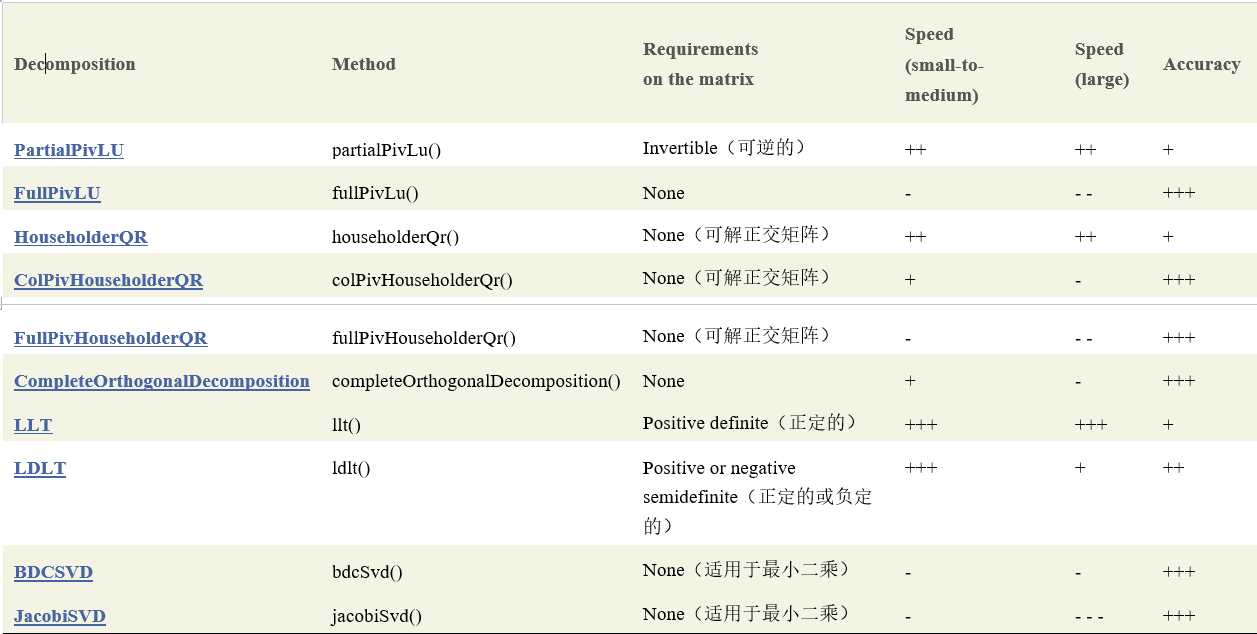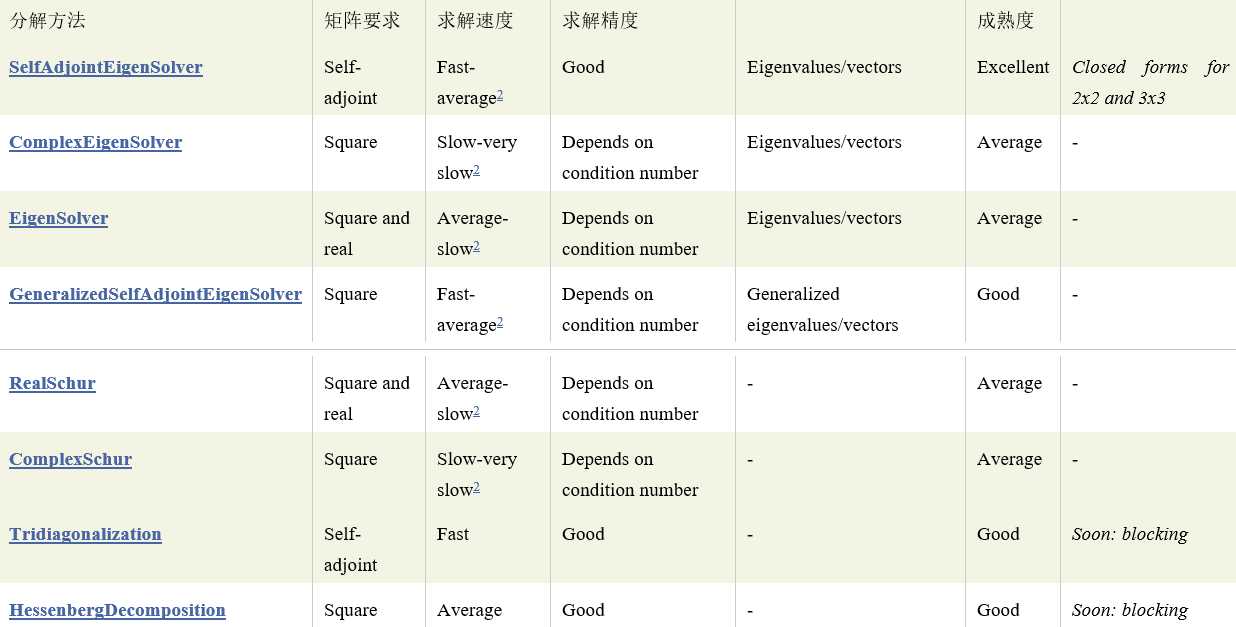标签:stand 方法 ati ima ade general clu mes test
一、稠密矩阵分解
方法有PartialPivLU、FullPivLU、HouseholderQR、ColPivHouseholderQR、FullPivHouseholderQR、CompleteOrthogonalDecomposition、LLT、LDLT、BDCSVD、JacobiSVD、

以下线性求解器eigen没有提供

示例:
#include <iostream>
#include <Eigen/Dense>
using namespace std;
using namespace Eigen;
int main()
{
Matrix3f A;
Vector3f b;
A << 1,2,3, 4,5,6, 7,8,10;
b << 3, 3, 4;
cout << "Here is the matrix A:\n" << A << endl;
cout << "Here is the vector b:\n" << b << endl;
Vector3f x = A.colPivHouseholderQr().solve(b);
cout << "The solution is:\n" << x << endl;
}
2、ldlt()
#include <iostream>
#include <Eigen/Dense>
using namespace std;
using namespace Eigen;
int main()
{
Matrix2f A, b;
A << 2, -1, -1, 3;
b << 1, 2, 3, 1;
cout << "Here is the matrix A:\n" << A << endl;
cout << "Here is the right hand side b:\n" << b << endl;
Matrix2f x = A.ldlt().solve(b);
cout << "The solution is:\n" << x << endl;
}
3、fullPivLu()
#include <iostream>
#include <Eigen/Dense>
using namespace std;
using namespace Eigen;
int main()
{
MatrixXd A = MatrixXd::Random(100,100);
MatrixXd b = MatrixXd::Random(100,50);
MatrixXd x = A.fullPivLu().solve(b);
double relative_error = (A*x - b).norm() / b.norm(); // norm() is L2 norm
cout << "The relative error is:\n" << relative_error << endl;
}
4、计算特征值和特征向量eigenvalues eigenvectors
#include <iostream>
#include <Eigen/Dense>
using namespace std;
using namespace Eigen;
int main()
{
Matrix2f A;
A << 1, 2, 2, 3;
cout << "Here is the matrix A:\n" << A << endl;
SelfAdjointEigenSolver<Matrix2f> eigensolver(A);
if (eigensolver.info() != Success) abort();
cout << "The eigenvalues of A are:\n" << eigensolver.eigenvalues() << endl;
cout << "Here‘s a matrix whose columns are eigenvectors of A \n"
<< "corresponding to these eigenvalues:\n"
<< eigensolver.eigenvectors() << endl;
}
5、计算逆和行列式 inverse and determinant
#include <iostream>
#include <Eigen/Dense>
using namespace std;
using namespace Eigen;
int main()
{
Matrix3f A;
A << 1, 2, 1,
2, 1, 0,
-1, 1, 2;
cout << "Here is the matrix A:\n" << A << endl;
cout << "The determinant of A is " << A.determinant() << endl;
cout << "The inverse of A is:\n" << A.inverse() << endl;
}
6、计算最小二乘解bdcSvd JacobiSVD
#include <iostream>
#include <Eigen/Dense>
using namespace std;
using namespace Eigen;
int main()
{
MatrixXf A = MatrixXf::Random(3, 2);
cout << "Here is the matrix A:\n" << A << endl;
VectorXf b = VectorXf::Random(3);
cout << "Here is the right hand side b:\n" << b << endl;
cout << "The least-squares solution is:\n"
<< A.bdcSvd(ComputeThinU | ComputeThinV).solve(b) << endl;
}
7、LLT
#include <iostream>
#include <Eigen/Dense>
using namespace std;
using namespace Eigen;
int main()
{
Matrix2f A, b;
LLT<Matrix2f> llt;
A << 2, -1, -1, 3;
b << 1, 2, 3, 1;
cout << "Here is the matrix A:\n" << A << endl;
cout << "Here is the right hand side b:\n" << b << endl;
cout << "Computing LLT decomposition..." << endl;
llt.compute(A);
cout << "The solution is:\n" << llt.solve(b) << endl;
A(1,1)++;
cout << "The matrix A is now:\n" << A << endl;
cout << "Computing LLT decomposition..." << endl;
llt.compute(A);
cout << "The solution is now:\n" << llt.solve(b) << endl;
}
线性最小二乘的求解
下面讨论线性最小二乘的求解的三种方法的使用---SVD分解、QR分解、法线方程。
SVD分解
#include <iostream>
#include <Eigen/Dense>
using namespace std;
using namespace Eigen;
int main()
{
MatrixXf A = MatrixXf::Random(3, 2);
cout << "Here is the matrix A:\n" << A << endl;
VectorXf b = VectorXf::Random(3);
cout << "Here is the right hand side b:\n" << b << endl;
cout << "The least-squares solution is:\n"
<< A.bdcSvd(ComputeThinU | ComputeThinV).solve(b) << endl;
}
还有一种方法JacobiSVD速度慢些。
QR分解
MatrixXf A = MatrixXf::Random(3, 2);
VectorXf b = VectorXf::Random(3);
cout << "The solution using the QR decomposition is:\n"
<< A.colPivHouseholderQr().solve(b) << endl;
HouseholderQR (no pivoting, so fast but unstable), ColPivHouseholderQR (column pivoting, thus a bit slower but more accurate) and FullPivHouseholderQR (full pivoting, so slowest and most stable)
法线方程 ATAx = ATb
MatrixXf A = MatrixXf::Random(3, 2);
VectorXf b = VectorXf::Random(3);
cout << "The solution using normal equations is:\n"
<< (A.transpose() * A).ldlt().solve(A.transpose() * b) << endl;
小结:the SVD decomposition is generally the most accurate but the slowest, normal equations is the fastest but least accurate, and the QR decomposition is in between.
标签:stand 方法 ati ima ade general clu mes test
原文地址:https://www.cnblogs.com/lovebay/p/12176211.html